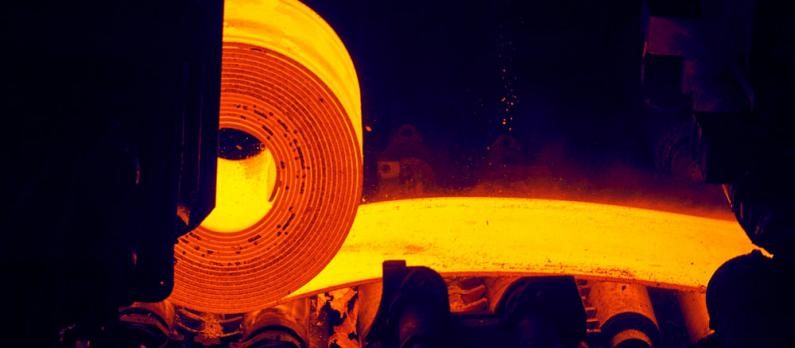Case story > SSAB, Finland.
Because everything in life needs to be in balance.

SSAB also reduces emissions in compressed air production

SSAB’s goal is fossil-free steel production from the mine to the end user. SSAB’s Raahe steel mill has, among other things, tested the replacement of fossil carbon with biochar. In compressed air production, emissions are reduced with a new energy-efficient turbo compressor.
SSAB’s Raahe plant produces standard, premium and special steel. Steel sheet and strip products, such as straight-hardened coils, are hot-rolled from steel billets weighing about 30 tonnes. Steel production generates a lot of carbon dioxide emissions. SSAB’s Raahe mill alone accounts for about seven percent of Finland’s CO2 emissions.
It was therefore natural that it was SSAB that began to think about how the technology could be used to combat climate change and reduce the carbon footprint of production. The solution was to replace fossil coal and coke with fossil-free electricity and hydrogen in production. In this way, the emissions are water vapor instead of carbon dioxide. The new production method is based on direct reduction, in which the pellets are reduced without smelting to iron. In production, blast furnaces are replaced by arc furnaces.
SSAB aims to produce commercial quantities of fossil-free steel in Sweden in 2026 and in all three Nordic production units by 2040.
Measures to reduce the environmental impact and emissions of production
SSAB has long taken measures to reduce the environmental impact and emissions of production. At the Raahe plant, for example, it has been possible to reduce CO2 emissions per ton of steel produced through improved energy efficiency. In addition, recycled steel is used in the production of steel.
A significant investment has been made in the removal of secondary dust and the plant’s waste heat is directed to the city’s district heating network. The plant also replaces oil-based fuels with liquefied natural gas, or LNG.
Energy savings through improvements in compressed air production
The Raahe plant has begun to look for ways to reduce electricity consumption and at the same time further reduce CO2 emissions. The plant uses a lot of compressed air, which requires a lot of energy to produce.
Pekka Virsiheimo, who is responsible for compressed air production, and the working group set up for the renovation work started to think about how the development of a compressed air system can save energy and increase production efficiency. The renovation was timely because the capacity of the equipment was running out and electricity consumption was increasing year by year.
In the initial situation, the plant’s main compressed air network equipment consisted of one turbo compressor and 19 screw compressors with an end-of-life cycle.
- The first step in the renovation was leak detection and leak repair of the ten-kilometer compressed air pipeline. The pipeline was converted into a ring network and expanded by two kilometers.
- Sarlin Balance has been used for compressed air control at the Raahe plant for 15 years, and its software was also updated to reflect the current situation.
- The condition check has been very useful and, for example, older, poor condition screw compressors may have been taken out of service.
- Sarlin Balance can be used to identify how much compressed air is going anywhere, and the change in consumption profile has also been reflected in the data.
Utilization of exhaust air blown by oxygen plant in the production of compressed air
The second step in the renovation was how the exhaust air blown out by the oxygen plant in the area can be utilized in compressed air production and at the same time increase the efficiency of the entire compressed air production.
The goal was to produce 300 cubic meters per minute with exhaust air, which corresponds to about 60 percent of the compressed air needed by the plant.
This is achieved according to the new model with two turbo compressors and two screw compressors. Old screw compressors operate as spare machines in the model.
The electricity consumption of compressed air decreases by 18 GWh per year
When everything is made to work optimally, there will be a decrease in electricity consumption of 18 GWh per year. This is also a big thing in reducing emissions alongside the reduction in energy costs, says Virsiheimo.
The target for the specific energy consumption of the new system is 3–5 kW/m3/minute. This means an improvement of about 50% in energy efficiency.
Hanwha SM6000 series turbocompressor was chosen
In the purchase of equipment, SSAB ended up with Hanwha SM6000 series oil-free turbo compressor with a 450 kW engine, supplied by Sarlin. In the acquisition, Virsiheimo emphasizes the wide capacity adjustability of the compressor model, which is 170–350 m3 per minute. The turbo compressor was taken into use more than a year ago.
– We ordered the compressor without logic control and hoped for other modifications to the standard equipment, because we modified the software package and the automation ourselves. We were pleased with how much the manufacturer came up with the modifications. Sarlin and Hanwha were also able to supply the turbo compressor to us on a fast schedule. This is a unique entity, Virsiheimo presents.
– An important part of the acquisition was to consider the life cycle costs of the turbo compressor. When maintenance and upkeep costs are lower than before, it is reflected in the total cost. For the new turbo compressor, a separate 170-square-meter elevation station was built on the plant site.
Collaboration with Sarlin
Virsiheimo states that the cooperation with Sarlin goes well and customer-oriented. Sarlin, he thinks, has been able to think of the factory as a whole, and answers to development ideas have been received. Sarlin has also been able to convey SSAB’s wishes to the Hanwha plant in Korea.
Jukka Järventaus, Sarlin’s key account manager, finds SSAB’s compressed air system renovation and modernization project interesting, because turbo compressors allow SSAB to operate their compressed air production in the best possible way and bring real savings in energy costs.
The data produced by Sarlin Balance has also been of concrete help. Reporting facilitates monitoring and thus everyday work.